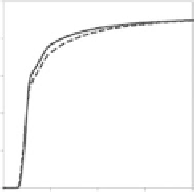Biomedical Engineering Reference
In-Depth Information
100
100
80
80
60
60
40
40
20
20
TCDDMA
800
ABPE300
0
0
200
400
600
800
1000
200
400
Wavelength (nm)
600
1000
Wavelength (nm)
(a)
(b)
Figure 9.7
Regular transmittance spectra of acetylated (solid line) and untreated (broken
line)BCnanocomposites (a)withtheTCDDMAresinmatrixand(b)withtheABPE300resin
matrix. (Reprinted with permission from Nogi, M.; Abe, K.; Handa, K.; Nakatsubo, F.;
Ifuku, S.; Yano, H., Propertyenhancement of optically transparent bionanofiber composites
by acetylation. Applied Physics Letters, 2006, 89(23), 233123, Copyright 2006, American
InstituteofPhysics.)
(a)
(b)
(c)
Figure 9.8
SEM images of (a) untreated, (b) DS 0.45 and (c) DS 1.55 BC samples. For all
photographs, the length of the scale bar is 500 nm (12). (Reprinted with permission from
Ifuku, S.; Nogi, M.; Abe, K.; Handa, K.; Nakatsubo, F.; Yano, H., Surfacemodification of
bacterialcellulosenanofibers forpropertyenhancementofopticallytransparentcomposites:
Dependence on acetyl-group DS. Biomacromolecules, 2007, 8(6), 1973-1978. Copyright
2007.AmericanChemicalSociety.)
bacterial cellulose sheets were first activated by UV irradiation after which they were
immersed in an acrylic acid solution and once again irradiated with UV (24). Thorough
washing of the membrane allowed removing unreacted chemicals. Weight gain percent-
age showed that the acrylic content increased linearly with the UV irradiation time up
to 25%. The acrylic acid apparently grafted to the cellulose as suggested from Fourier
transform infrared spectroscopy (FTIR) and filled in the pores of the bacterial cellulose
membrane such that the pore structure was no longer distinguishable after 20 min of
UV irradiation (Figure 9.10). Tensile strength and elongation at break of the dry mem-
branes also appeared to increase with the UV irradiation time up to 180 MPa and ca
6% elongation respectively (Figure 9.11). Besides the electrochemical properties of the
BC/acrylic composite were comparable to those of a commercial membrane (24).
In another publication a slightly different approach was used to manufacture BC/
acrylic interpenetrating networks (25).
Namely a purified and never dried bacterial





Search WWH ::

Custom Search